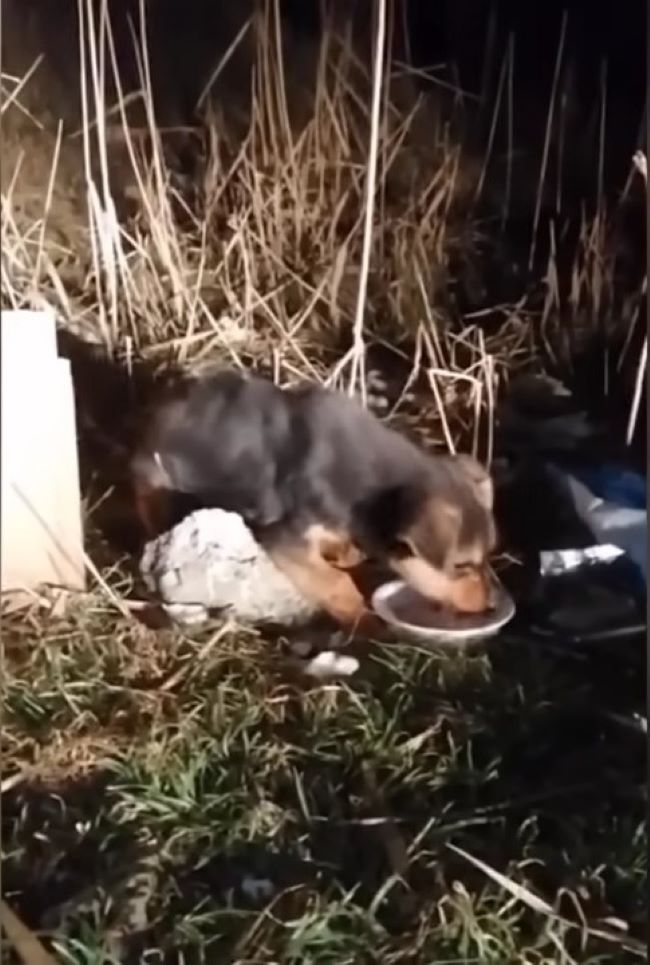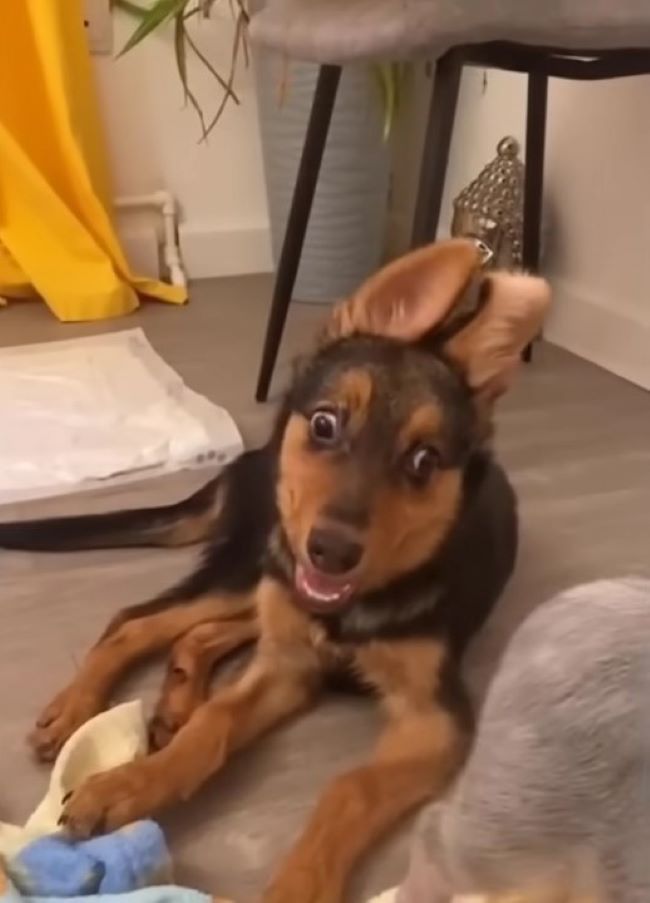There is perhaps nothing worse than seeing people neglect or abuse defenceless animals who can not get any help.
As it just happens, in the story we will talk about today, a driver was seen throwing a box out of his car, which was noticed by Good Samaritans who went to check it out.
To their surprise and horror, they found that there was a puppy inside, and she was just hurled out of the vehicle like she was nothing.
It’s absolutely horrible to think about, and I can’t understand why people would do something like this.
A Lucky Break

However, not everything was doom and gloom as the Good Samaritans had notified rescuers about this sweet puppy who needed help.
The girls decided to stay with her until help arrived, and they had waited for almost two hours.
The puppy was dumped next to a highway, which could have been incredibly dangerous if she was not found almost immediately.
Luckily, she was not hurt after being thrown out of the car. However, the dog was very hungry as she was likely not fed in a while.
The rescuers finally arrived and examined the dog. She needed to be taken to a veterinarian clinic so that they could do a checkup.

However, they first gave her something to eat and it was just heartbreaking to see how hungry she was.
She was then taken to the vet immediately after that, but unfortunately, it was late, and no one was there, so they tried the next day.
The rescuer examined the dog to see if there was anything wrong with her and noticed that there was indeed something unusual about her eyes and limbs.
As it turned out, she had a rare genetic disease called Periosteal Dysplasia, which was causing her a lot of problems, and nobody wanted her.
However, her rescuer was determined and would never abandon her. She took the sweet puppy home and decided to adopt her.
The Puppy’s Amazing Owner

One thing the rescuer noticed was that she was so happy around children and loved spending time with her daughter.
Everything was going great for a while; however, problems would soon start mounting up for this dog.
Her new owner noticed that her illness had just taken a turn for the worse, and she couldn’t even move her head.
Something was causing a strange drool from her mouth and she needed an examination fast so they could figure out a treatment.
The vets determined that the reason for the drooling was because of the dilation of the esophagus, which caused food to stagnate.

Another piece of heartbreaking news was that dogs with this kind of genetic disease typically do not live long, so who knows how much time they had.
Her new owner was heartbroken to hear that, but there was not much she could do about it other than buy her more time.
After the veterinarians treated her, she was discharged a few days later and taken back to her home.
Things have calmed for a while, and her owner is now even more determined than ever to give her the best life possible.
If this story can show us anything, it’s that all dogs, regardless of illness, have a lot of love to give and deserve a wonderful home. It’s up to us to give them that.
If you’ve ever noticed your furry companion constantly lapping up water like it’s going out of style, you’re not alone. Dogs, with their boundless energy and playful antics, can sometimes leave you wondering why they guzzle water like there’s no tomorrow. Understanding your dog’s drinking habits can offer insights into their overall well-being and behavior.
From playful pups to seasoned seniors, dogs have their unique reasons for hitting the water bowl more frequently. As a seasoned dog owner, deciphering the reasons behind your dog’s increased water intake can help you ensure they stay healthy and happy. So, grab a seat, and let’s dive into the fascinating world of why your four-legged friend might be turning into a water enthusiast.
Understanding Canine Hydration
Factors Affecting Your Dog’s Water Intake
To comprehend why your furry friend might be drinking more water than usual, you need to consider various factors that influence their water intake. The reasons can range from environmental conditions to health issues. It’s essential to observe your dog’s drinking habits to identify any changes that could indicate an underlying concern.
Signs of Proper Hydration in Dogs
Recognizing the signs of proper hydration in dogs is crucial for their well-being. A well-hydrated pup will have clear, odorless urine, moist gums, and a well-hydrated nose. Monitoring these indicators can help you ensure that your dog is maintaining adequate levels of hydration, promoting good health and happiness.
Common Reasons for Increased Water Consumption in Dogs
Dietary Influences on Thirst
What your dog eats can significantly affect how much water they need. A diet high in dry kibble may lead to increased water intake as dogs require more water to digest dry food properly. Wet food, on the other hand, contains moisture already, reducing the need for excess water consumption.
Activity Levels and Environmental Factors
Just like us, dogs drink more water when they’re active or when it’s hot outside. Increased physical activity or exposure to warm temperatures can result in higher water intake to help regulate body temperature and replace fluids lost through panting and sweating.
The Role of Medications and Supplements
Certain medications or supplements prescribed for your dog may have side effects like increased thirst. It’s essential to be aware of any new additions to your dog’s health regimen and consult your veterinarian if you notice a sudden change in water consumption after starting a new medication or supplement.
Health-Related Causes of Excessive Drinking
Kidney Disease and Diabetes in Dogs
Kidney disease and diabetes are common health issues in dogs that can lead to excessive drinking. These conditions affect your dog’s ability to regulate water properly, causing them to drink more to try to compensate. If you notice your dog drinking significantly more water than usual, it’s essential to have them evaluated by a veterinarian to rule out these serious conditions.
Hormonal Disorders Affecting Thirst
Hormonal disorders, such as Cushing’s disease or thyroid issues, can impact your dog’s thirst levels. These disorders can disrupt the balance of hormones in your dog’s body, leading to increased water consumption. If your dog is constantly seeking out water and urinating more frequently, especially in combination with other symptoms like weight changes or lethargy, it’s crucial to consult with your vet for further evaluation.
Other Medical Conditions to Consider
In addition to kidney disease, diabetes, and hormonal disorders, there are other medical conditions that could contribute to excessive drinking in dogs. Conditions like liver disease, urinary tract infections, or certain types of cancer can also manifest as increased thirst. It’s important to monitor your dog’s water intake closely and seek veterinary attention if you notice any significant changes in their drinking habits to ensure prompt diagnosis and appropriate treatment.
When to Consult the Veterinarian
Monitoring Water Intake and Urination Habits
To determine if your dog’s water consumption is excessive, you should monitor their water intake and urination habits. Keep an eye on how much water they are drinking throughout the day and how frequently they urinate. If you notice a significant increase in water intake or more frequent urination, it could be a sign of an underlying issue that requires veterinary attention.
Diagnostic Tests and What to Expect
If you suspect that your dog is drinking more water than usual, the next step is to consult a veterinarian for diagnostic tests. The vet may recommend blood tests to check for conditions like kidney disease, diabetes, or hormonal disorders. Additionally, they might suggest urine tests to rule out urinary tract infections or other issues. During the consultation, be prepared to provide information on your dog’s symptoms, diet, and any medications they are taking.
Make sure to consult your veterinarian promptly if you observe any significant changes in your dog’s water intake or urination habits. Early detection and treatment of underlying health conditions can help ensure your furry companion stays happy and healthy.
Tips for Managing Your Dog’s Water Intake
Establishing a Healthy Drinking Routine
To ensure your dog maintains a healthy water intake, establish a consistent drinking routine. Offer fresh water regularly throughout the day, especially after meals and playtime. Encouraging your dog to drink at specific times can help regulate their water consumption.
Choosing the Right Water Bowls and Placement
Selecting the appropriate water bowls and their placement is crucial. Opt for sturdy, easy-to-clean bowls that are the right size for your dog. Place the water bowls in easily accessible areas where your dog feels comfortable drinking. Consider using multiple water bowls in different locations, especially if you have a large home or multiple pets.
Conclusion
Keep an eye on your furry friend’s water drinking habits as it could be a sign of underlying health issues. From kidney disease to diabetes, excessive thirst in dogs can indicate various medical conditions. Remember, regular monitoring and prompt veterinary attention are key to ensuring your dog’s well-being. By staying observant and proactive, you can help your pup lead a happy and healthy life. Don’t hesitate to reach out to your vet if you notice any unusual changes in your dog’s water intake. Remember, your pup’s health comes first!
Frequently Asked Questions
Why is monitoring a dog’s water intake important?
Monitoring a dog’s water intake is crucial as it can indicate underlying health issues. Changes in water consumption could point to medical conditions that require attention.
What are some health-related causes of excessive drinking in dogs?
Health-related causes of excessive drinking in dogs include kidney disease, diabetes, hormonal disorders like Cushing’s disease and thyroid issues, liver disease, urinary tract infections, and cancer.
Why is it important to consult a veterinarian if a dog shows signs of increased thirst?
Consulting a veterinarian is essential to ensure timely diagnosis and appropriate treatment for any underlying health conditions causing increased thirst in dogs.
What diagnostic tests should be considered for a dog showing changes in water consumption?
Blood and urine tests are recommended for dogs showing changes in water consumption to help identify any potential health issues early on.
What are some tips for managing a dog’s water intake?
Offer fresh water regularly, choose suitable water bowls, and place them in easily accessible areas to establish a healthy drinking routine for your dog.
[no_toc]

Hey there, I’m Janet Brooks, a dog-loving student from California. I’m all about helping pups in need, especially those without homes. Me and my awesome friends work together to give shelter and love to stray dogs. Oh, and I also write blogs about dogs to share helpful info.